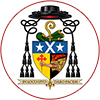I hope it will not seem too strange that I begin the homily for Holy Thursday, which is to be about the institution of the Eucharist, by taking you back to the beginning of Jesus’ public ministry as narrated by John, to the marriage feast at Cana.
Of course there are connections that are immediately obvious: that was the first time we saw, through the Evangelist’s eyes, Jesus at table with his disciples, and this is the last. Both are marriage feasts: the first a real wedding that is also a symbolic one; the last the true wedding that the other symbolized, the new covenant that brings about the union between the heavenly Bridegroom and the Church. At both Jesus gives the new wine, the best wine that is kept until the end.
At both festal meals, Jesus shares with his disciples his glory. At Cana, ‘he revealed his glory, and his disciples believed in him.’ At the last supper, his prayer for his disciples that is also his last will and testament, is: ‘My will is that where I am, they may be with me, that they may see my glory.’
But I am going back to Cana to find the Mother of Jesus, so that she may lead us into the marriage feast. That is what she does at Cana. The evangelist is very careful in his choice of words at the opening of this scene: ‘There was a wedding at Cana in Galilee, and the mother of Jesus was there. Jesus and his disciples were also invited to the wedding.’ She is the one who asks Jesus to provide wine. He will not, apparently, because, he says, ‘My hour has not come.’
Now the hour has come: ‘Jesus knew that the hour had come for him to pass from this world to the Father.’ And when the hour comes, Mary is there, addressed by Jesus from the Cross using the same title with which he addressed her at Cana: ‘Woman.’
If she is at the last supper, we don’t see her. She becomes visible to us only when Jesus casts his eyes on her from the Cross.
John makes omissions from his narrative of the last supper that are as thought-provoking as what he says. He doesn’t mention the institution of the eucharist, the bread of life and the chalice of salvation. He has already spoken of the bread of life. And of the chalice he will speak tomorrow. John wants us to go straight to the heart of things. He wants us to understand the eucharist by gazing directly at Jesus on the Cross. The other Gospels follow the historical sequence of events, describing first Jesus’ institution of the Eucharistic sacrifice at his last Passover meal with his disciples, then his bloody sacrifice on calvary the following day. John superimposes the image of a Passover meal on the image of Jesus crucified. So in his narrative Jesus is led out to be crucified at the very hour when the Passover lambs are being slaughtered in preparation for the feast, and he is laid in the tomb as the evening of the Passover celebration is approaching.
On Palm Sunday, listening to the Passion according to Matthew, we heard Jesus say, as he instituted the Eucharist, that he would not drink again of the fruit of the vine until he drank it new with his disciples in the Kingdom of his Father. And so, in Matthew’s narrative, when Jesus is offered wine to drink before his execution, tasting it, he refused to drink it. In John’s narrative, Jesus’ final action, from the Cross, is to call for drink, saying ‘I thirst.’ Then he drinks the fruit of the vine: the very opposite of the good wine that he given at Cana, cheap sour wine, the wine of the poor and criminals, vinegar. With this drink he proclaimed the consummation of his work, and poured out the new wine, the blood of the new covenant.
Tonight, at this celebration of the Eucharist, we occupy the place of the Beloved Disciple, who at the last supper was close to the heart of Jesus, in terms evoking John’s description of Jesus’ intimacy with the Father. As the Son is ‘in the bosom of the Father’, so close is the Beloved Disciple to Jesus. All the disciples at the last supper share this closeness to Jesus. But Holy Thursday passes into Good Friday, and on Good Friday all the disciples will scatter and go their own way, abandoning Jesus, all except the one Beloved Disciple. He will stand at the Cross, with the Mother of Jesus. That is why at the beginning of this Triduum we ask Mary to accompany us into the feast: so that we can be faithful, so that we can stand with her at the foot of the Cross.
Abbot Anselm Atkinson OSB
